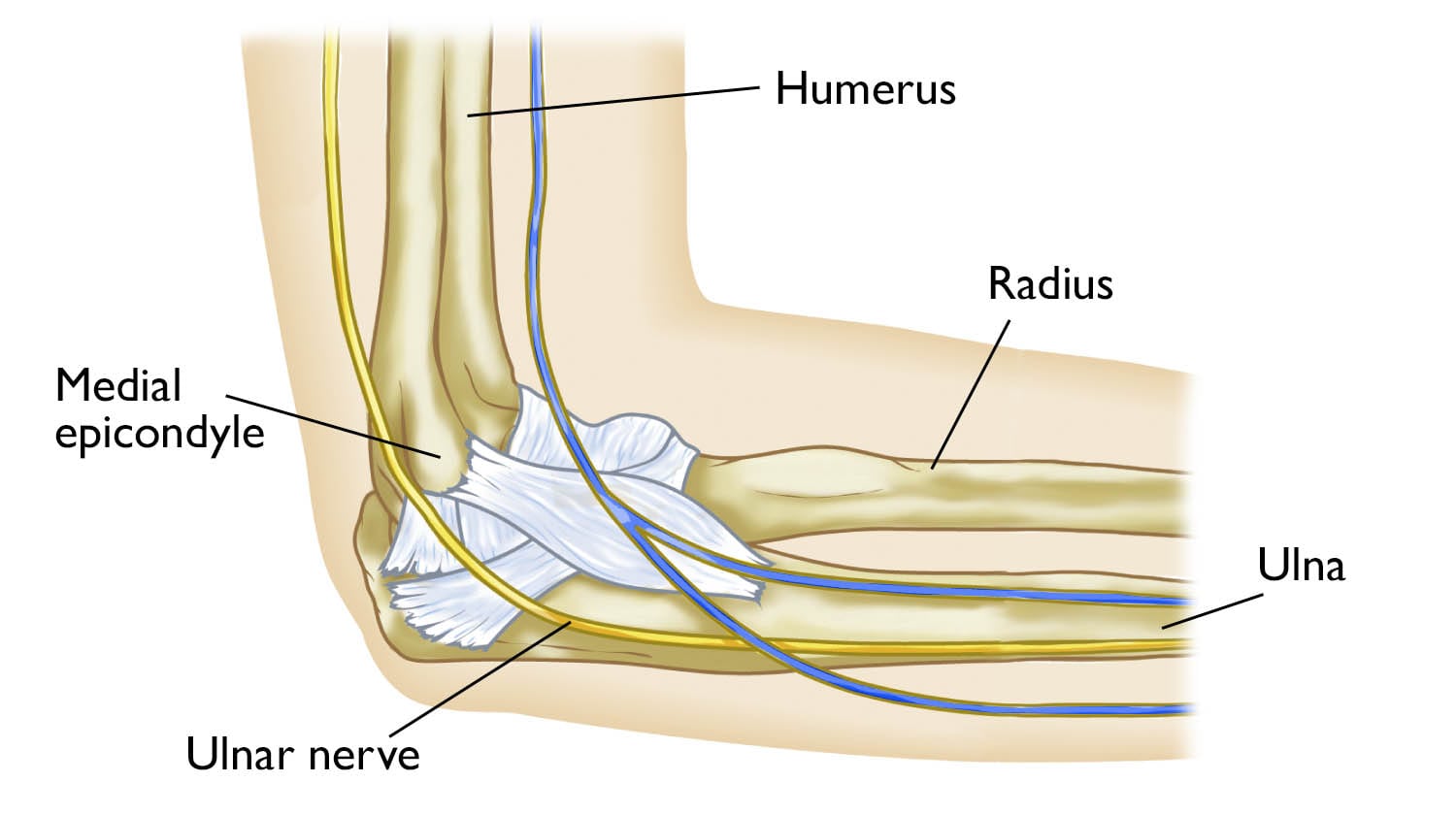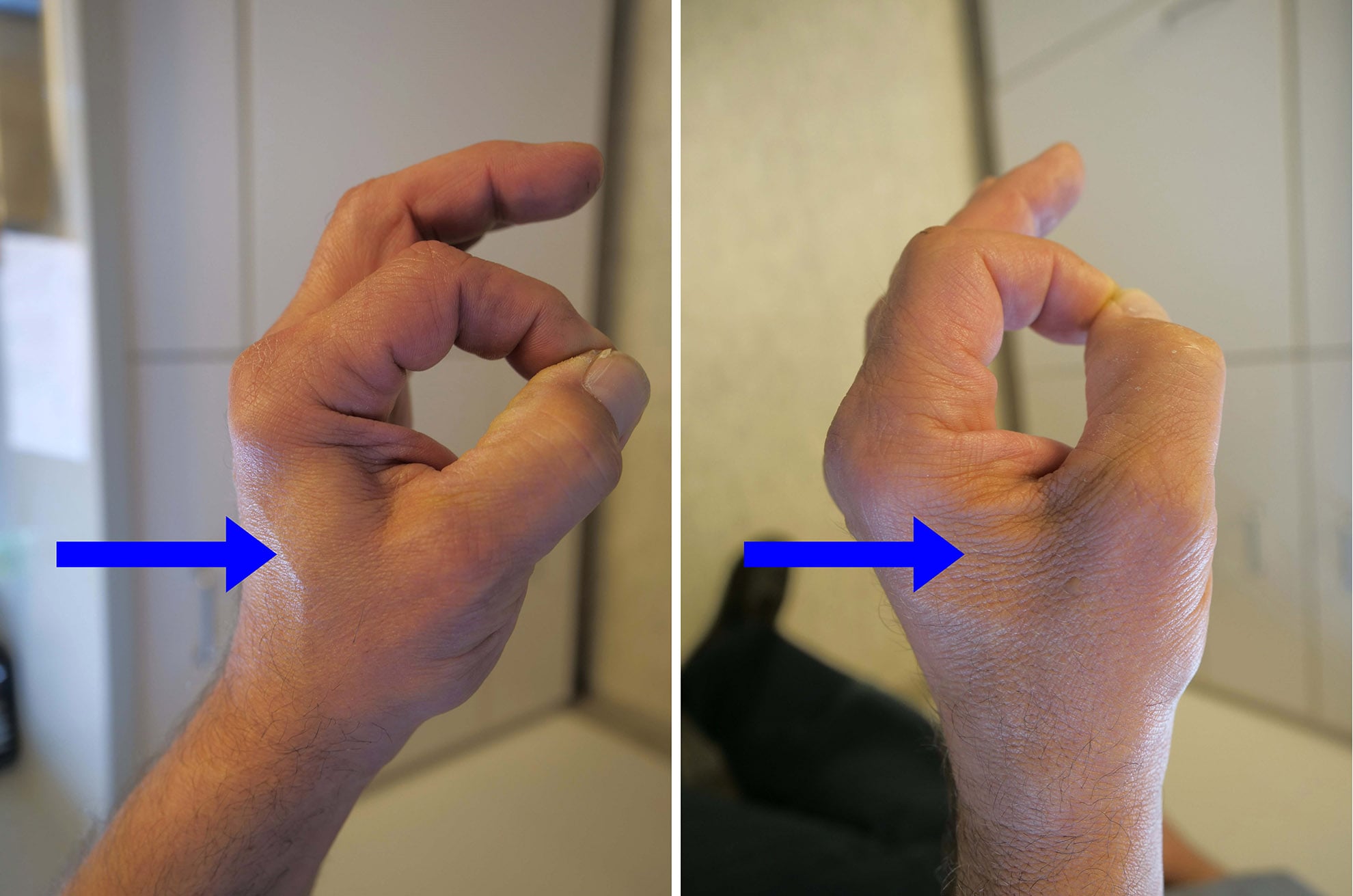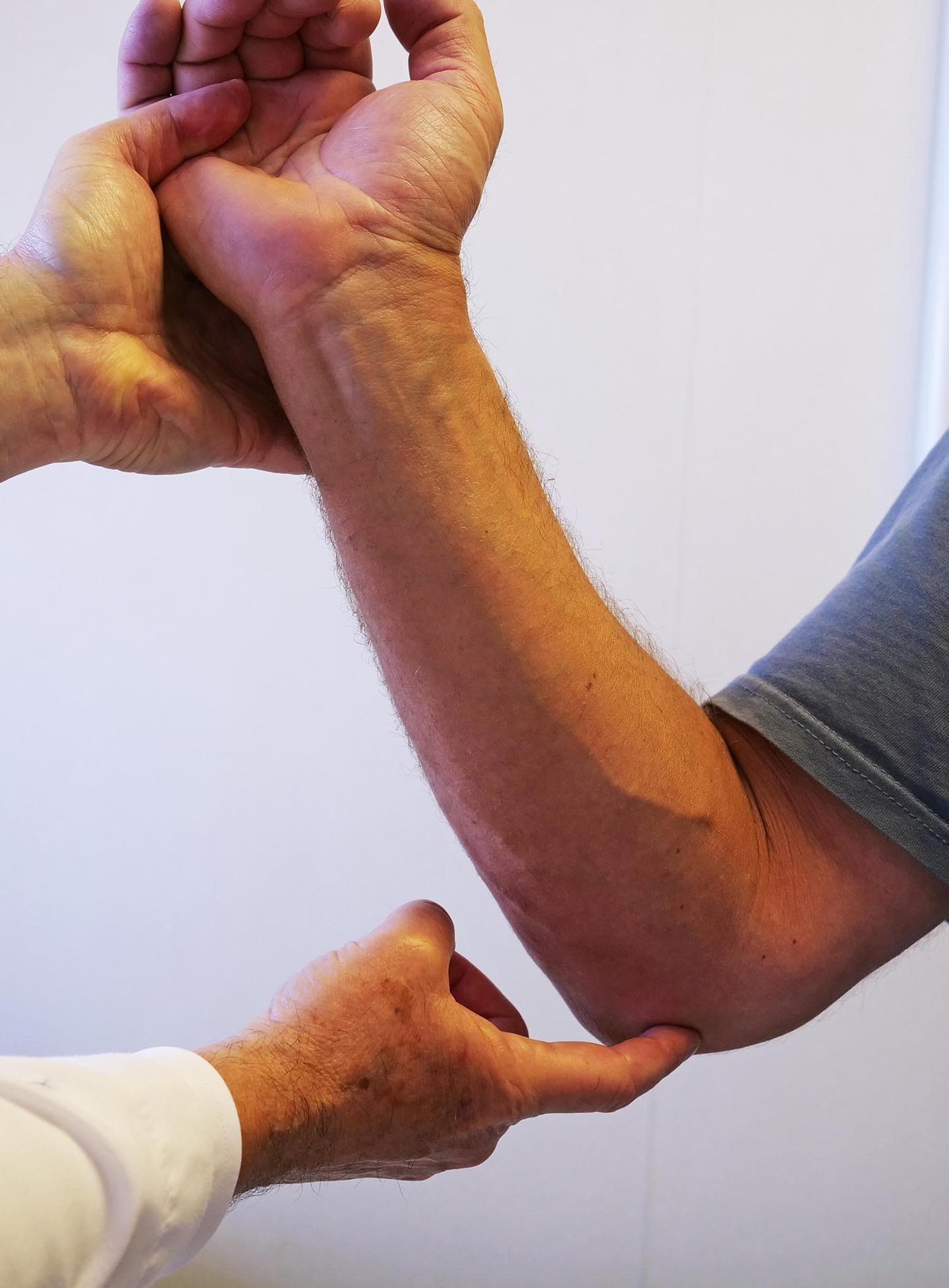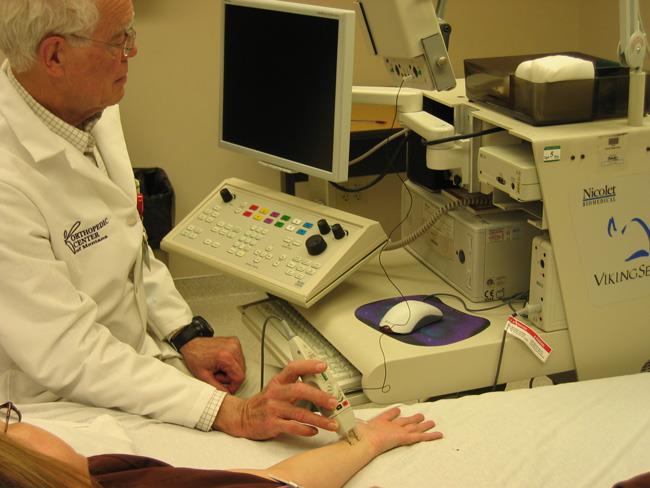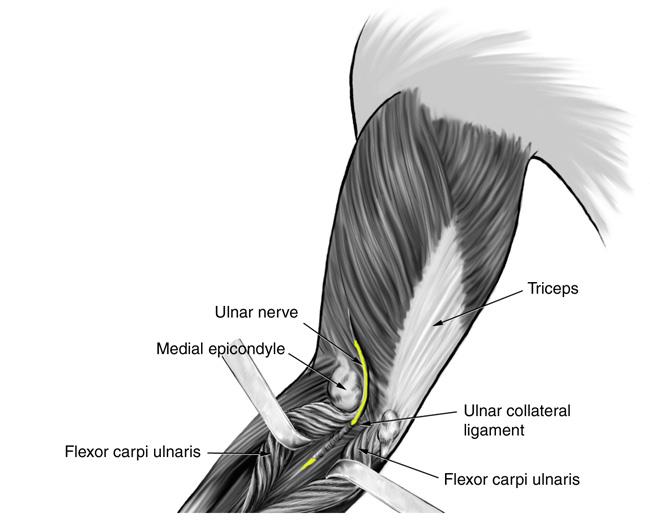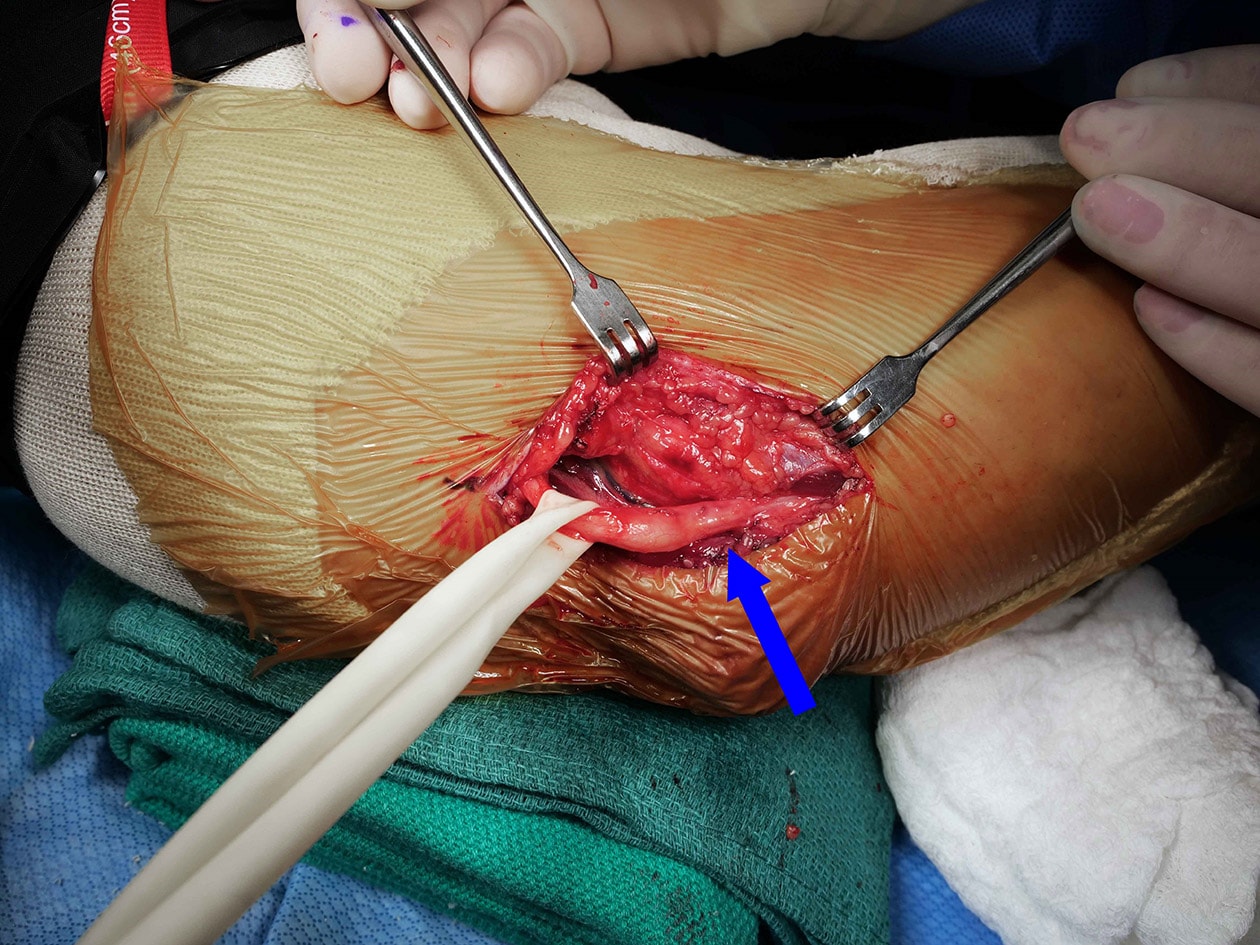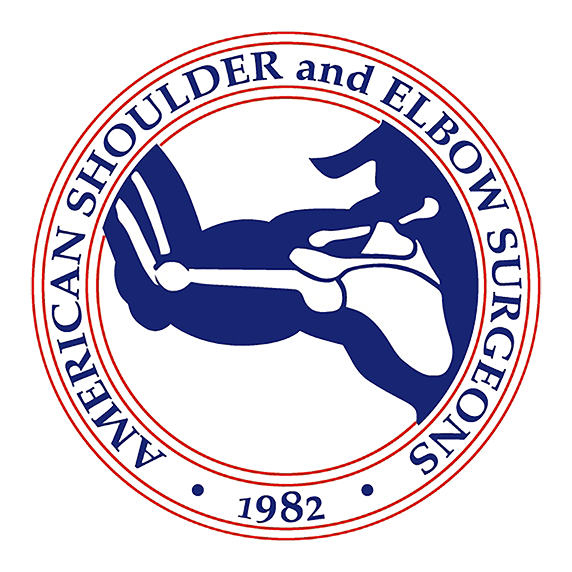Diseases & Conditions
Ulnar Nerve Entrapment at the Elbow (Cubital Tunnel Syndrome)
Ulnar nerve entrapment occurs when the ulnar nerve in the arm becomes compressed (squeezed or restricted) or irritated.
The ulnar nerve is one of the three main nerves in your arm. It travels from your neck down into your hand and can be constricted in several places along the way, such as beneath the collarbone or at the wrist.
The most common place for compression of the nerve is behind the inside part of the elbow. Ulnar nerve compression at the elbow is called cubital tunnel syndrome.
Numbness and tingling in the pinky and ring fingers are common symptoms of cubital tunnel syndrome.
- In most cases, symptoms can be managed with nonsurgical treatments like changes in activities and bracing.
- If nonsurgical methods do not improve your symptoms, or if the nerve compression is causing muscle weakness or damage in your hand, your doctor may recommend surgery to take pressure off the nerve and allow it to move more freely.
Anatomy
At the elbow, the ulnar nerve travels through a tunnel of tissue (the cubital tunnel) that runs under a bump of bone at the inside of your elbow. This bony bump is called the medial epicondyle. The spot where the nerve runs under the medial epicondyle is commonly referred to as the "funny bone." At the funny bone, the nerve is close to your skin, and bumping it causes a shock-like feeling.
Beyond the elbow, the ulnar nerve travels under muscles on the inside of your forearm and into your hand on the side of the palm with the pinky finger. As the nerve enters the hand, it travels through another tunnel (Guyon's canal).
The ulnar nerve gives feeling to the little finger and half of the ring finger. It also controls most of the little muscles in the hand that help with fine movements, and some of the bigger muscles in the forearm that help you make a strong grip.
Cause
In many cases of cubital tunnel syndrome, the exact cause is not known.
The ulnar nerve is especially vulnerable to compression at the elbow because it must travel through a narrow space with very little soft tissue to protect it. Also, when you bend your elbow, you slightly compress and stretch the nerve and decrease its blood supply. This is often why the symptoms of cubital tunnel syndrome get worse when the elbow is bent.
Common Causes of Compression
There are several things that can cause pressure on the nerve at the elbow:
- When you bend your elbow, the ulnar nerve must stretch around the bony ridge of the medial epicondyle. Because this stretching can irritate the nerve and decrease its blood supply, keeping your elbow bent for long periods or repeatedly bending your elbow can cause painful symptoms. For example, many people sleep with their elbows bent, which can aggravate symptoms of ulnar nerve compression and cause you to wake up at night or in the morning with your fingers asleep.
- In some people, the nerve slides out from behind the medial epicondyle when the elbow is bent. Over time, this sliding back and forth may irritate the nerve.
- Leaning on your elbow for long periods of time can put pressure on the nerve.
- Fluid buildup in the elbow can cause swelling that may compress the nerve.
- A direct blow to the inside of the elbow can cause pain, electric shock sensation, and numbness in the little and ring fingers. This is commonly called "hitting your funny bone."
- Throwing a baseball puts a large amount of stress on the inside of the elbow and can sometimes lead to ulnar nerve irritation.
Risk Factors
Some factors put you more at risk for developing cubital tunnel syndrome. These include:
- Prior fracture or dislocation of the elbow
- Bone spurs/arthritis of the elbow
- Swelling of the elbow joint
- Cysts near the elbow joint
- Repetitive or prolonged activities that require the elbow to be bent or flexed
- Baseball pitching
Symptoms
Cubital tunnel syndrome can cause an aching pain on the inside of the elbow. Most of the symptoms, however, occur in your hand.
- Numbness and tingling in the ring finger and little finger are common symptoms of ulnar nerve entrapment. Often, these symptoms come and go. They happen more often when the elbow is bent, such as when driving or holding the phone. Some people wake up at night because their fingers are numb.
- The feeling of "falling asleep" in the ring finger and little finger, especially when your elbow is bent. In some cases, it may be harder to move your fingers in and out, or to manipulate objects.
- Weakening of the grip and difficulty with finger coordination (such as typing or playing an instrument) may occur. These symptoms are usually seen in more severe cases of nerve compression.
- If the nerve is very compressed or has been compressed for a long time, muscle wasting in the hand can occur. Once this happens, muscle wasting cannot be reversed. For this reason, it is important to see your doctor:
- If symptoms are severe, or
- If symptoms are less severe but have been present for more than 6 weeks
Home Remedies
There are many things you can do at home to help relieve symptoms. If your symptoms interfere with normal activities or last more than a few weeks, be sure to schedule an appointment with your doctor.
- Avoid activities that require you to keep your arm bent for long periods of time.
- If you use a computer frequently, make sure that your chair is not too low. Do not rest your elbow on the armrest.
- Avoid leaning on your elbow or putting pressure on the inside of your arm. For example, do not drive with your arm resting on the open window.
- Keep your elbow straight at night when you are sleeping. This can be done by wrapping a towel around your straight elbow or wearing an elbow pad backwards.
Doctor Examination
Medical History and Physical Examination
Your doctor will discuss your medical history and general health. They may also ask about your work, your activities, and what medications you are taking.
After discussing your symptoms and medical history, your doctor will examine your elbow and hand to determine which nerve is compressed and where it is compressed. The doctor may also do a neck exam, as pinched nerves in the neck can cause similar symptoms.
Some of the physical examination tests your doctor may do include:
- Tap over the nerve at the funny bone. If the nerve is irritated, tapping can cause a shock into the little finger and ring finger (Tinel's sign) — although this can happen when the nerve is normal as well.
- Check whether the ulnar nerve slides out of normal position when you bend your elbow.
- Move your neck, shoulder, elbow, and wrist to see if different positions cause symptoms.
- Check for feeling and strength in your hand and fingers.
Tests
X-rays. X-rays provide detailed pictures of bone. Most causes of compression of the ulnar nerve cannot be seen on an X-ray. However, your doctor may take X-rays of your elbow or wrist to look for bone spurs, arthritis, or other places where the bone may be compressing the nerve.
Nerve conduction studies. These tests can determine how well the nerve is working and help identify where it is being compressed. The test sends an electric current down the arm and looks to see if the current gets slowed along its path. If the current gets slowed down, this is likely an area of nerve compression. This can also help the doctor determine whether the pinched nerve is at the elbow, wrist, or neck.
Nerves are like electrical cables that travel through your body carrying messages between your brain and muscles. When a nerve is not working well, it takes longer for it to conduct.
Nerve conduction studies can also determine whether the compression is causing muscle damage. During the test, small needles are put into some of the muscles that the ulnar nerve controls. Muscle damage (especially with wasting) is a sign of more severe nerve compression.
Treatment
Unless your nerve compression has caused disability or any muscle wasting, your doctor will most likely recommend trying nonsurgical treatment first.
Nonsurgical Treatment
Nonsteroidal anti-inflammatory drugs (NSAIDs). If your symptoms have just started, your doctor may recommend an anti-inflammatory medicine, such as ibuprofen or naproxen, to help reduce swelling around the nerve.
Although steroids, such as cortisone, are very effective anti-inflammatory medicines, steroid injections are generally not used to treat cubital tunnel syndrome because there is a risk of damage to the nerve. However, sometimes your doctor will prescribe a short course of oral steroids (taken by mouth) to help relieve the inflammation around the nerve.
Bracing or splinting. Your doctor may prescribe a padded brace or splint to wear at night to keep your elbow in a straight position.
Nerve gliding exercises. Some doctors think that exercises to help the ulnar nerve slide through the cubital tunnel at the elbow and the Guyon's canal at the wrist can improve symptoms. These exercises may also help prevent stiffness in the arm and wrist.
Surgical Treatment
Your doctor may recommend surgery to take pressure off of the nerve if:
- Nonsurgical methods have not improved your condition
- The ulnar nerve is very compressed
- Nerve compression has caused muscle weakness or damage
There are a few surgical procedures that will relieve pressure on the ulnar nerve at the elbow. Your orthopaedic surgeon will talk with you about the option that would be best for you.
These procedures are generally done on an outpatient basis (where you go home the same day as your surgery).
Cubital tunnel release. In this operation, the ligament roof of the cubital tunnel is cut and divided. This increases the size of the tunnel and decreases pressure on the nerve.
After the procedure, the ligament begins to heal, and new tissue grows across the division. The new growth heals the ligament and allows more space for the ulnar nerve to slide through.
Cubital tunnel release tends to work best when the nerve compression is mild or moderate and the nerve does not slide out from behind the bony ridge of the medial epicondyle when the elbow is bent.
Ulnar nerve transposition. In most cases, the nerve is moved from its place behind the medial epicondyle to a new place in front of it. Moving the nerve to the front of the medial epicondyle keeps it from getting caught on the bony ridge and stretching when you bend your elbow. It allows a more direct path for the nerve and removes the compression on the nerve when you bend your elbow. This procedure is called a transposition of the ulnar nerve.
Surgical Recovery
- Depending on the type of surgery you have, you may need to wear a splint for a few days to weeks after the operation. A submuscular transposition usually requires a longer time (3 to 6 weeks) in a splint.
- Most patients are allowed to move their elbow right away to prevent any scarring of the nerve.
- While motion often starts immediately, you will avoid any heavy lifting with the arm for a few weeks.
- Your surgeon may recommend physical therapy exercises to help you regain strength and motion in your arm. They will also talk with you about when it will be safe to return to all your normal activities.
Surgical Outcome
The results of surgery are generally good. Each method of surgery has a similar success rate for routine cases of nerve compression.
If the nerve is very badly compressed or if there is muscle wasting, the nerve may not be able to return to normal, and some symptoms may remain even after the surgery. Nerves recover slowly, and it may take a long time to know how well the nerve will do after surgery.
Contributed and/or Updated by
AAOS does not endorse any treatments, procedures, products, or physicians referenced herein. This information is provided as an educational service and is not intended to serve as medical advice. Anyone seeking specific orthopaedic advice or assistance should consult his or her orthopaedic surgeon, or locate one in your area through the AAOS Find an Orthopaedist program on this website.








